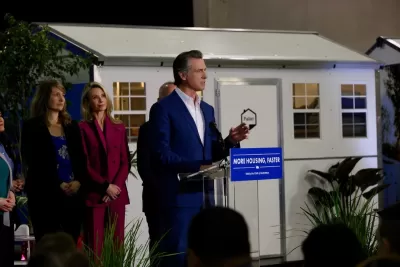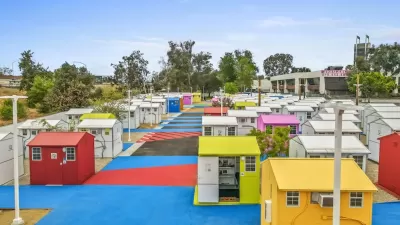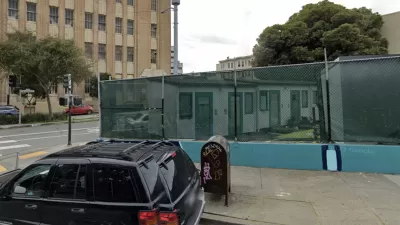A promise to fund 1,200 tiny homes for unhoused residents in four cities as a way to rapidly and cost-effectively provide shelter has yet to yield tangible results, but projects are moving ahead in some cities.

Despite a promise from California Governor Gavin Newsom to distribute 1,200 ‘tiny homes’ for unhoused people a year ago, none of the units have yet materialized, reports Marisa Kendall in CALmatters. According to Kendall, only 150 units have been ordered.
There have been multiple delays and about-faces, over everything from the way the state is funding the units to the ability of local cities and counties to find places to put them. The state has suggested the delays are the fault of local governments. But tiny homes have failed to materialize even when local leaders moved quickly to approve a project site.
The governor’s original plan called for delivering 500 tiny homes to Los Angeles, 350 to Sacramento, 200 to San Jose, and 150 to San Diego County. Then, the state decided to send the city cash grants instead, leaving cities with a funding gap. In San Jose, the city will cover the difference to proceed with opening its tiny home project in 2025. In other cities, sites haven’t yet been selected.
The six tiny home manufacturers selected by the state expressed surprise they haven’t received many orders. “Several said they had to design new products specifically to meet the state’s strict requirements for everything from vapor-resistant light fixtures to emergency exit lighting.”
FULL STORY: Newsom promised 1,200 tiny homes for homeless Californians. A year later, none have opened

Alabama: Trump Terminates Settlements for Black Communities Harmed By Raw Sewage
Trump deemed the landmark civil rights agreement “illegal DEI and environmental justice policy.”

Planetizen Federal Action Tracker
A weekly monitor of how Trump’s orders and actions are impacting planners and planning in America.

Why Should We Subsidize Public Transportation?
Many public transit agencies face financial stress due to rising costs, declining fare revenue, and declining subsidies. Transit advocates must provide a strong business case for increasing public transit funding.

Understanding Road Diets
An explainer from Momentum highlights the advantages of reducing vehicle lanes in favor of more bike, transit, and pedestrian infrastructure.

New California Law Regulates Warehouse Pollution
A new law tightens building and emissions regulations for large distribution warehouses to mitigate air pollution and traffic in surrounding communities.

Phoenix Announces Opening Date for Light Rail Extension
The South Central extension will connect South Phoenix to downtown and other major hubs starting on June 7.
Urban Design for Planners 1: Software Tools
This six-course series explores essential urban design concepts using open source software and equips planners with the tools they need to participate fully in the urban design process.
Planning for Universal Design
Learn the tools for implementing Universal Design in planning regulations.
Caltrans
Smith Gee Studio
Institute for Housing and Urban Development Studies (IHS)
City of Grandview
Harvard GSD Executive Education
Toledo-Lucas County Plan Commissions
Salt Lake City
NYU Wagner Graduate School of Public Service





























